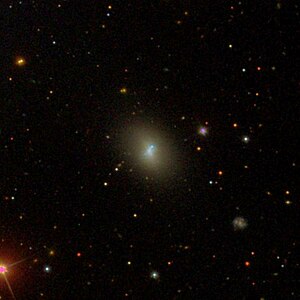NGC 7077
| Galaxy NGC 7077 |
|
|---|---|

|
|
| SDSS recording | |
| AladinLite | |
| Constellation | Aquarius |
|
Position equinox : J2000.0 , epoch : J2000.0 |
|
| Right ascension | 21 h 29 m 59.6 s |
| declination | + 02 ° 24 ′ 51 ″ |
| Appearance | |
| Morphological type | E1 / HII |
| Brightness (visual) | 13.0 likes |
| Brightness (B-band) | 14.0 mag |
| Angular expansion | 0.80 ′ × 0.7 ′ |
| Position angle | 37 ° |
| Surface brightness | 12.4 mag / arcmin² |
| Physical data | |
| Affiliation | isolated |
| Redshift | 1152 ± 5 |
| Radial velocity | 0.003843 ± 0.000017 km / s |
|
Stroke distance v rad / H 0 |
(59 ± 4) · 10 6 ly (18.0 ± 1.3) Mpc |
| history | |
| discovery | Albert Marth |
| Discovery date | August 11, 1863 |
| Catalog names | |
| NGC 7077 • UGC 11755 • PGC 66860 • CGCG 375-047 • MCG + 00-54-028 • IRAS F21274 + 0211 • 2MASX J21295963 + 0224517 • Mrk 900 • GALEX ASC J212959.56 + 022452.3 • KIG 916/917 | |
NGC 7077 is an elliptical dwarf galaxy with extended star formation from the Hubble type E1 in the constellation Aquarius on the ecliptic . It is estimated to be 59 million light years from the Milky Way and about 15,000 light years across.
The galaxies NGC 7081 , IC 1380 , IC 5111 are located in the same area of the sky .
The galaxy lies in the Local Void , a huge, empty region of space next to our local group .
The object was discovered by Albert Marth on August 11, 1863 .
